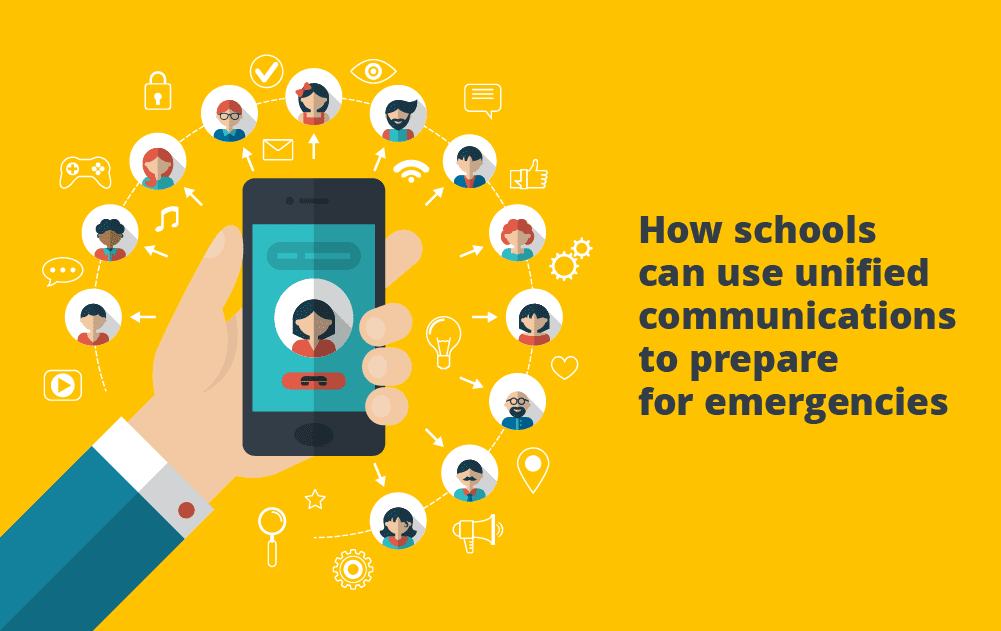Schools and colleges spent nearly $3.1 billion on security and safety products and services in 2021. One of the products near the top of that list was alert and communications technology.
From mass shootings to natural disasters, schools face continuous threats that are eroding the sense of well-being and safety on campuses and in classrooms. It’s what the American Psychological Association calls a “cascade of collective traumas.”
Preparation and planning are essential to protecting K–12 and college communities during an emergency. Comprehensive and effective communication is crucial for keeping stakeholders connected, informed, and supported.
When Natural Disasters Strike
In 2021, the United States experienced 20 weather/climate disasters that grossed over a billion dollars in damages. What stands out about these natural disasters is not just the economic impact but the variety of severity of the events: extreme heat/droughts, flooding, hail, hurricanes, tornadoes, severe weather/wind, wildfires, and winter storms.
Despite our best efforts, weather tracking isn’t foolproof, and we can only make informed guesses in most cases. Waiting until the moment we hear sirens that signal impending disaster is not the time to create and test an emergency plan. Advanced planning is a must.
Proactive planning. Natural disasters can cause significant damage to property, infrastructure, and life, so it’s important to be prepared and proactive rather than improvising in the moment. For schools especially, communication is essential for protecting students and faculty, promoting safety, responding to the situation, mitigating damages, and moving forward. Planning involves inclusive input, testing, and refining, and it’s necessary to engage the entire student body and staff by conducting safety drills. It also means informing the community about procedures for contacting parents and first responders.
Practice and preparation. Knowing what to do when the alarm or the siren goes off is fundamental, but it’s also vital to know who is doing what. Repetition and communication are necessary for refining these skills. Think of young students experiencing their first fire drill: after several practices, they know how to check for heat and smoke, if it’s safe to exit through the door, who’s the line leader, and where to meet safely. The value of this exercise is proven. This same planning and practice can be applied to all emergency situations.
Mission-critical communications. Communication plans, tools, and systems are mission-critical during a natural disaster. Thanks in part to the pandemic, many school districts now use unified communications (UC) as part of their daily routines. With the need to keep faculty, administration, and students connected and learning, UC tools such as video conferencing, file sharing, and collaboration are the norm for many.
A UC solution also can help when an emergency upends the daily routine, allowing seamless and simultaneous communications across multiple channels, which is especially important when it’s unclear which channels are operational and accessible during a disaster.
A cloud based UC system is a perfect solution. They’re hosted off-site and insulated from the impact of local events on the ground. With a desktop softphone or mobile app, communications are accessible from any internet-enabled device, regardless of location. School personnel can even coordinate with coworkers and emergency personnel to ensure the safety of staff and students.
Broadcast texting also can alert parents of the situation and deliver written instructions for how and when to safely collect their children.
Intruders and Active Shooters
Proper precautions help keep school property safe from unauthorized access and minimize risks to everyone on campus. Surveillance, access control, and identification methods are all best practices to prevent intrusions on campuses. Unfortunately, with staff and security budgets stretched thin, it’s easy to inadvertently give an unwanted person access to the campus or buildings.
The FBI designated 61 active shooter situations in 2021; two occurred on a school campus. Like other disaster scenarios, taking the “it won’t happen to me” approach can have far-reaching, tragic results. Instead, it’s necessary to prepare for the worst and hope for the best.
Staff response. As with any emergency, faculty and staff are often the eyes and ears of a developing situation. Awareness is key. The sooner a danger is identified, the sooner preventative measures such as lockdowns and law enforcement alerts can be activated. Communication is key, and messages need to be taken seriously. It helps to have a designated chain of command and official communication channels ready to deploy at a second’s notice without depending on disparate legacy technology.
Intruder alert. Would-be intruders are challenging to identify until they have access to the premises, at which point it’s an emergency. You don’t have time to devise a response plan: protocols should already be in place and refined. What and how you communicate must be ready at a second’s notice.
Communications in a crisis. The right safety solutions and communications channels are crucial and time-sensitive in these situations. Unifying communications tools into an easy-to-use app eliminates toggling between apps when every second counts. Immediacy and expediency are necessary to reach campus security, police, administrators, parents, and students in as many ways as possible — email, text, voice calls, social media, and web updates — all at once.
Meanwhile, cloud based broadcast texting can provide instant updates to worried parents. Because it’s cloud based, mass texting can be initiated anywhere, from any mobile device. No one needs to be a “hero” and put themselves unnecessarily in harm’s way trying to communicate from the front office switchboard.
Urgent Communications Call for UC
Planning and preparation aside, predicting human reactions in a crisis is difficult, but unified communications solutions can help ease the burden. Schools and parents need to be equally involved in preparing for emergencies; the school must implement and refine procedures, drills, and safety measures, and parents need to ensure their contact information is correct across all channels. All parties need to understand the policies and protocols for evacuation, access, meet-up locations, and communications.
Contact Broadvoice to learn more about how cloud based unified communications help prepare schools for emergencies.








